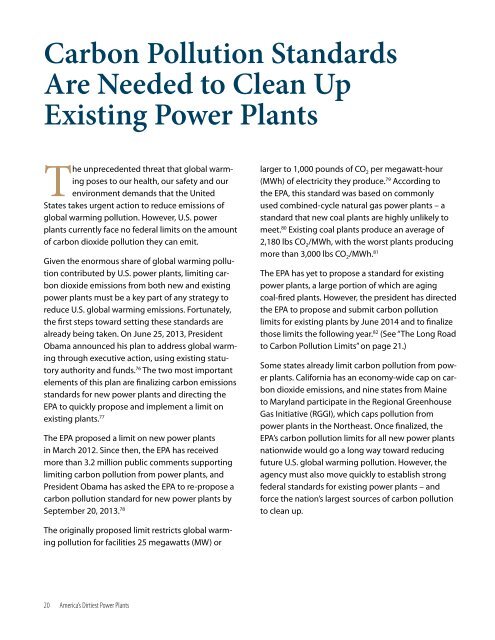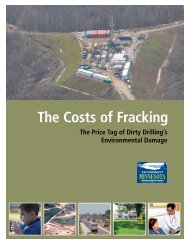America’s Dirtiest Power Plants
America's Dirtiest Power Plants - Environment Minnesota
America's Dirtiest Power Plants - Environment Minnesota
- No tags were found...
You also want an ePaper? Increase the reach of your titles
YUMPU automatically turns print PDFs into web optimized ePapers that Google loves.
Carbon Pollution Standards<br />
Are Needed to Clean Up<br />
Existing <strong>Power</strong> <strong>Plants</strong><br />
The unprecedented threat that global warming<br />
poses to our health, our safety and our<br />
environment demands that the United<br />
States takes urgent action to reduce emissions of<br />
global warming pollution. However, U.S. power<br />
plants currently face no federal limits on the amount<br />
of carbon dioxide pollution they can emit.<br />
Given the enormous share of global warming pollution<br />
contributed by U.S. power plants, limiting carbon<br />
dioxide emissions from both new and existing<br />
power plants must be a key part of any strategy to<br />
reduce U.S. global warming emissions. Fortunately,<br />
the first steps toward setting these standards are<br />
already being taken. On June 25, 2013, President<br />
Obama announced his plan to address global warming<br />
through executive action, using existing statutory<br />
authority and funds. 76 The two most important<br />
elements of this plan are finalizing carbon emissions<br />
standards for new power plants and directing the<br />
EPA to quickly propose and implement a limit on<br />
existing plants. 77<br />
The EPA proposed a limit on new power plants<br />
in March 2012. Since then, the EPA has received<br />
more than 3.2 million public comments supporting<br />
limiting carbon pollution from power plants, and<br />
President Obama has asked the EPA to re-propose a<br />
carbon pollution standard for new power plants by<br />
September 20, 2013. 78<br />
larger to 1,000 pounds of CO 2 per megawatt-hour<br />
(MWh) of electricity they produce. 79 According to<br />
the EPA, this standard was based on commonly<br />
used combined-cycle natural gas power plants – a<br />
standard that new coal plants are highly unlikely to<br />
meet. 80 Existing coal plants produce an average of<br />
2,180 lbs CO 2 /MWh, with the worst plants producing<br />
more than 3,000 lbs CO 2 /MWh. 81<br />
The EPA has yet to propose a standard for existing<br />
power plants, a large portion of which are aging<br />
coal-fired plants. However, the president has directed<br />
the EPA to propose and submit carbon pollution<br />
limits for existing plants by June 2014 and to finalize<br />
those limits the following year. 82 (See “The Long Road<br />
to Carbon Pollution Limits” on page 21.)<br />
Some states already limit carbon pollution from power<br />
plants. California has an economy-wide cap on carbon<br />
dioxide emissions, and nine states from Maine<br />
to Maryland participate in the Regional Greenhouse<br />
Gas Initiative (RGGI), which caps pollution from<br />
power plants in the Northeast. Once finalized, the<br />
EPA’s carbon pollution limits for all new power plants<br />
nationwide would go a long way toward reducing<br />
future U.S. global warming pollution. However, the<br />
agency must also move quickly to establish strong<br />
federal standards for existing power plants – and<br />
force the nation’s largest sources of carbon pollution<br />
to clean up.<br />
The originally proposed limit restricts global warming<br />
pollution for facilities 25 megawatts (MW) or<br />
20 <strong>America’s</strong> <strong>Dirtiest</strong> <strong>Power</strong> <strong>Plants</strong>



